Quote-to-Cash Configuration
Note:
The Quote-to-Cash integration requires HubSpot's Sales Hub Professional edition or higher.
Product synchronization
The price points for plans, addons, and charges in Chargebee are synced to products in HubSpot. Moreover, both metered and non-metered products are supported.See the field-mapping details for the product object to know how each field of a product in HubSpot is populated with data from Chargebee. For a given plan, addon, or charge, the price points with the same billing frequencies are synced to the same product (and hence SKU) in HubSpot. While syncing a price point, the existing HubSpot product SKUs are looked up for a match before creating a new product. The products are synced to the root product folder, and you can reorganize them as needed.
If multiple Chargebee sites are connected to one HubSpot account, and these sites have an identical product with the same SKU, the integration syncs the product SKU only once to HubSpot. For example, a merchant has two Chargebee sites, site A and site B, and the product Standard Plan(SKU-Standard-plan-monthly) exists on both sites. If the integration syncs the product SKU Standard-plan-monthly to HubSpot as part of site A, the sales user can create a subscription out of a deal by adding the product for site A only. The product with the same SKU cannot be synced again to HubSpot as part of site B.
Note:
Any changes made to HubSpot products are not synced back to Chargebee. It is recommended that such changes be made in Chargebee directly so that they are reflected in HubSpot on the next sync
Supported pricing models
The integration allows syncing Chargebee plans, addons, and charges with price points created using any pricing model to HubSpot products. However, during the sync of tiered, volume, and stairstep price points, Chargebee only syncs the price that is set for the lowest tier as HubSpot does not support tiered pricing and allows you to store only a single value for the price component of a product.
For example, if there is a plan with the following tiered price points in Chargebee:
| Plan/Addon ID | Plan/Addon Price Point External Name | Pricing Model | Billing Frequency | Units | Price per unit |
|---|---|---|---|---|---|
premium_plan | Premium Plan - Monthly | Tiered | Monthly | 1-20 | USD 200 |
premium_plan | Premium Plan - Monthly | Tiered | Monthly | 21-40 | USD 190 |
premium_plan | Premium Plan - Monthly | Tiered | Monthly | 41-& Above | USD 160 |
The above tiered price points are synced into HubSpot in the following manner:
| SKU | Product Name | Recurring billing frequency | Price |
|---|---|---|---|
premium_plan-1-month | Premium Plan - Monthly | Monthly | USD 200 |
You can also create subscriptions automatically from deals and create checkout links for products that have price points of type flat fee, per unit, and volume. The integration will create subscriptions or checkout links with the price set at the deal line item level. However, you can manually modify the price if you do not want to set the price that is auto-synced to HubSpot. For example, as shown in the above table, the premium_plan has a price set for a defined quantity range. As HubSpot does not store tier-based pricing, the integration will sync the lowest tier price USD 200, but you can set a price of your choice that will override the synced price.
You can also create subscriptions using the UI button for products that have price points created using any of the pricing models available in Chargebee.
Supported billing frequencies
The table below lists all the supported recurring billing frequencies in HubSpot and the corresponding billing frequencies in Chargebee.
| "Recurring billing frequency" in HubSpot | Matching "Billing frequency" in Chargebee |
|---|---|
| Quarterly | Every 3 months |
| Semi-annually | Every 6 months |
| Every two years | Every 2 years |
| Every three years | Every 3 years |
| Monthly | Monthly |
| Annually | Yearly |
Any price points created in Chargebee for billing frequencies not listed here (such as weekly, daily, and other custom frequencies) are not synced to HubSpot products. However, these limitations are not in effect when using the Create Subscription button.
Product sync examples
In this section, we look at some example scenarios to understand how plans, addons, and charges are synced as products in HubSpot.
Syncing plans and addons
The table below shows a couple of price points created for a plan and an addon each in Chargebee:
| Plan/Addon ID | Plan/Addon Price Point External Name | Billing Frequency | Price |
|---|---|---|---|
| additional_users | Additional Users - 6 Months | Every 6 months | EUR 250 |
| additional_users | Additional Users - 6 Months | Every 6 months | USD 299 |
| premium_plan | Premium Plan - Annually | Yearly | USD 599 |
| premium_plan | Premium Plan - Annually | Yearly | EUR 500 |
The above price points are synced as HubSpot products in the following manner:
| SKU | Product Name | Recurring Billing Frequency | Price |
|---|---|---|---|
| premium_plan-1-year | Premium Plan - Annually | Annually | USD 599 |
| premium_plan-1-year | Premium Plan - Annually | Annually | EUR 500 |
| additional_users-6-month | Additional Users - 6 Months | Semi-annually | USD 299 |
| additional_users-6-month | Additional Users - 6 Months | Semi-annually | EUR 250 |
If a price point has changed since the last sync, the attributes of the price point overwrite the attributes of the mapped HubSpot product on the next sync. Chargebee allows for billing attributes such as the number of billing cycles (mapped to Term in HubSpot) or Price Point External Name (mapped to Product Name) to be different for different currencies. HubSpot on the other hand, for a given product, defines only one Term or Product Name, regardless of currency.
Note:
As a result, it is strongly recommended that for all price points of a plan or addon in Chargebee, you keep the values of all attributes (except price) the same.
Syncing charges
The table below shows a couple of price points created for a charge in Chargebee:
| Charge ID | Charge Price Point External Name | Price |
|---|---|---|
| implementation_charge | Implementation Charge | USD 100 |
| implementation_charge | Implementation Charge | EUR 90 |
The above price points are synced as HubSpot products in the following manner:
| SKU | Product Name | Recurring billing frequency | Price |
|---|---|---|---|
| implementation_charge | Implementation Charge | One-time | USD 100 |
| implementation_charge | Implementation Charge | One-time | EUR 90 |
See also
Refer to the field-mapping referencefor the Product object to understand how each Product field in HubSpot is modified/synced.
Business entities
Note:
The multi-entity feature is not supported for multi-site scenarios. While you can have a single site with multi-entity enabled, it is not possible to have multiple sites with multi-entity enabled. The Multi Business Entity feature is a private beta release. Contact support to enable it.
The integration allows you to select business entities configured for your Chargebee site to connect to your HubSpot account. The connected business entities are available for selection on the HubSpot company records to create subscriptions for the required business entities in Chargebee.
For a single Chargebee site, you can connect single or multiple business entities with your HubSpot account.
- If the Chargebee site is configured with a single business entity, the entity is preselected while setting up the integration.
- If the Chargebee site is configured with multiple business entities, you can select the entities while configuring the Chargebee HubSpot Quote-to-Cash integration.
Select business entities
To select business entities, follow the below steps.
- Click Apps > Go to Marketplace > Sales & CRM.
- Select HubSpot Quote To Cash under the Apps connected section.
- On the right pane, select Manage sync preferences.
- Click Select Business Entities and choose the required entities.
- Click Apply Changes.
Business entities synchronization
Through the integration, the selected business entities are available for selection in the HubSpot company Business Entity Name field.
Customer Linking
The company and contact object in HubSpot are mapped to the customer object in Chargebee, and subscriptions are created for the customer from deals associated with the company and contact. You can choose to link customers in Chargebee to companies in HubSpot in the following ways.
- 1:1 - One customer in Chargebee to one company in HubSpot.
- N:1 - Many customers in Chargebee to one company in HubSpot.
When you configure the quote-to-cash integration, by default, the integration maps one customer in Chargebee to one company in HubSpot (1:1). If you wish to map many customers in Chargebee to a single customer in HubSpot (N:1), follow the steps outlined in select customer linking and configure sync rules for customers.
Note:
- When 1:1 is selected it will be selected at the Company level.
- When N:1 is selected, site and business entity selection will happen at the Contact level.
The following table illustrates how N:1 customer linking is implemented.
| HubSpot Deal | HubSpot company and contact | How are customers created in Chargebee? |
|---|---|---|
| Deal 1 | Company: Zencorp | While creating a subscription out of deal 1:
|
| Deal 2 | Company: Zencorp | While creating a subscription out of deal 2:
|
| Deal 3 | Company: Sony | While creating a subscription out of deal 3:
|
If you have already configured the HubSpot Quote-to-Cash integration, you can use the customer linking option by clicking the Access Now button as shown in the below screenshot.
Select customer linking
To select customer linking, follow these steps.
- Click Apps > Go to Marketplace > Sales & CRM.
- Click HubSpot Quote To Cash under the Apps connected section.
- On the right pane, select Manage sync preferences.
- In Manage Preferences, click Select Customer Linking.
- Turn on the Link multiple Chargebee Customers to one HubSpot company toggle and set up sync rules for customers.
Warning
- Once the customer linking option has been enabled, it cannot be disabled. In order to disable it, you must reconfigure the integration.
- If you are linking multiple Chargebee customers to one HubSpot company that is already enabled, the HubSpot Quote to Cash integration will not sync company changes from HubSpot to Chargebee. Only contact changes will be synced back to Chargebee, as the Customer to Contacts mapping remains 1:1.
Sync rules for customers
The integration allows you to configure how the customer data in Chargebee is synced to company and contact records in HubSpot. Choose the required configurations and click Proceed.
The following settings are available to configure sync rules for the customer.
Sync Rules for Chargebee Customers to HubSpot
This setting allows you to configure data sync between Chargebee customers and HubSpot companies and contacts. After syncing a customer, the integration links that customer to a Company and its associated Contact in HubSpot.
-
Select Customers you want to sync with HubSpot The following options are available.
- All Customers
- Customers with active or non-renewing subscriptions only
-
When a matching Company or Contact already exists in HubSpot With this option, the integration attempts to identify a matching contact based on its email address and then locate a matching company using the domain name of the email address and the company name of the customer. Upon finding a match, the integration sets up a link between Chargebee and HubSpot to synchronize data.
- Select how data from Chargebee should flow into matched HubSpot objects
The following options are available.
- Overwrite HubSpot fields
- Update empty HubSpot fields
- Link records only
- When a Company or Contact or both do not exist in HubSpot In the event that no match or a partial match is found, the integration updates the matched object in accordance with the option selected in steps #1 and #2. Furthermore, it creates the missing records, associates them with one another, and links them with the Chargebee customer.
- Select how data from Chargebee should flow into matched HubSpot objects
The following options are available.
Note:
- The priority subscription for a customer is derived from the following, the integration will pick the 100 most recently updated subscriptions associated with a customer, and choose the highest ranking based on the below criteria.
- ACTIVE: 7
- NON_RENEWING: 6
- IN_TRIAL: 5
- FUTURE: 4
- PAUSED: 3
- CANCELED: 2
- When two subscriptions match the criteria, the integration will pick the most recently updated subscription.
Sync Rules for Updates to linked objects
This setting allows you to configure how Chargebee and HubSpot should sync changes to linked records.
- When a customer is updated in Chargebee
The following options are available.
- Overwrite HubSpot Fields with Chargebee data.
- Do Nothing
- When a Company or Contact is updated in HubSpot
The following options are available.
- Overwrite Chargebee fields with HubSpot data.
- Do Nothing
- When a customer record is updated in Chargebee and in HubSpot at the same time.
This option is visible only when the value for the above settings (1 and 2) are set to overwrite.
- Overwrite HubSpot fields with Chargebee data.
- Overwrite Chargebee fields with HubSpot data
- Flag the record and let me decide
Sync rules for subscriptions
Sync Chargebee subscriptions to HubSpot deals, either by creating a new deal or by mapping to an existing deal. You can configure settings to decide what subscriptions should be synced to deals in HubSpot, set deal stages based on subscription status, and automate creating deals for a subscription in Chargebee. This sync will allow you to access all the important data related to the subscription in HubSpot directly without logging in to Chargebee.
###Sync Rules for HubSpot Deals to Chargebee
To enable this feature, follow these steps: Select how you want to sync Deal Discount to Subscription
-
Price Override: Line item discount transferring from HubSpot Deals to Chargebee subscriptions will reflect as a Price Override.
-
Manual Discount: If your Chargebee plan supports Manual Discounting you can select this option. It will ensure any discount applied to deal line items will appear in Chargebee as a manual discount.
To use manual discount feature the following one time setup is required:
- Enable manual discounting within Chargebee. If already enabled, start with step 2.
- Navigate to Apps > HubSpot(New) > Manage Sync Preferences.
- In Select how you want to sync Deal Discount to Subscription section, select the Manual Discount option.
- Click Save.
- Now in HubSpot, navigate to any deal, select add deal line items, in the top right corner select Edit Columns.
- Select following options from the list
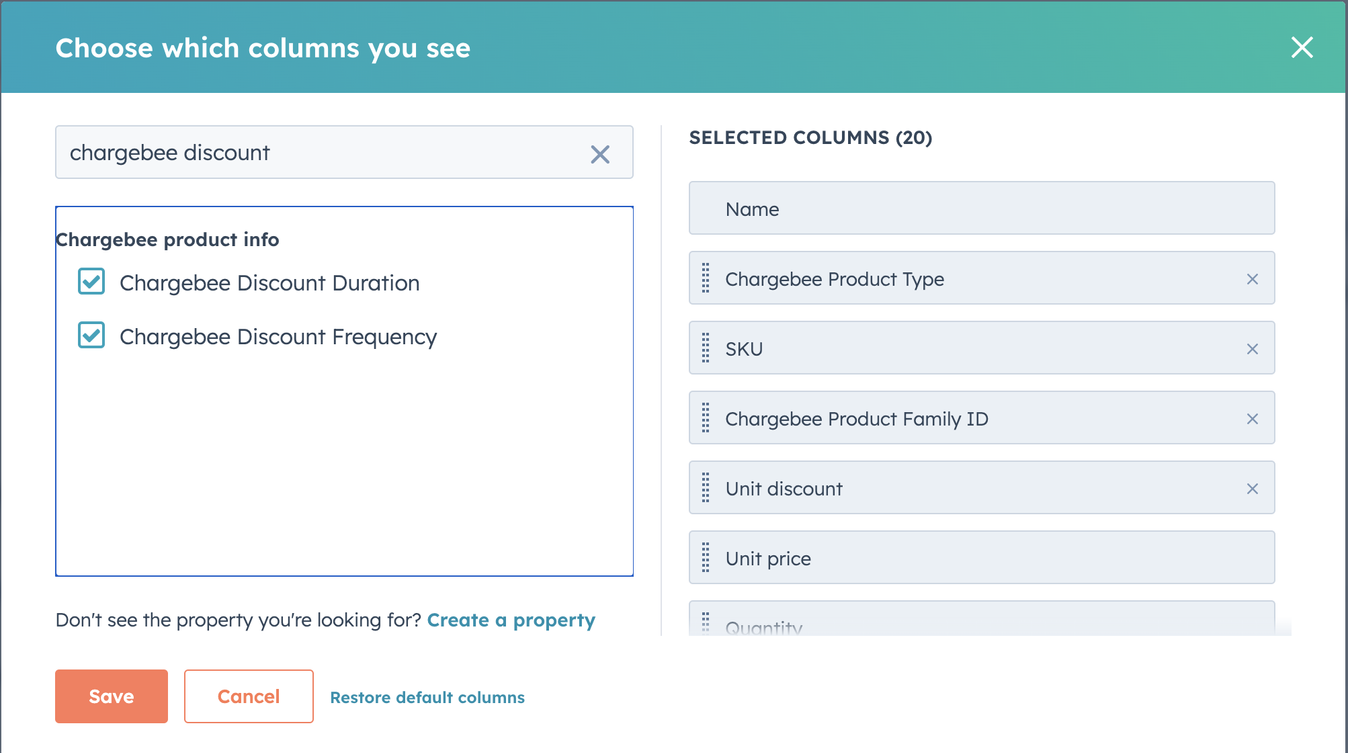
- Chargebee Discount Duration
Chargebee discount duration has following three possible values. These options indicates how long the Unit Discount is applicable to the related Chargebee line item.
- Forever
- One Time
- Fixed Duration
Note: For Fixed Duration use the Chargebee Discount Frequency field to specify a duration in Months. This field is only used when the duration is set to fixed, otherwise it is ignored and considered Forever.
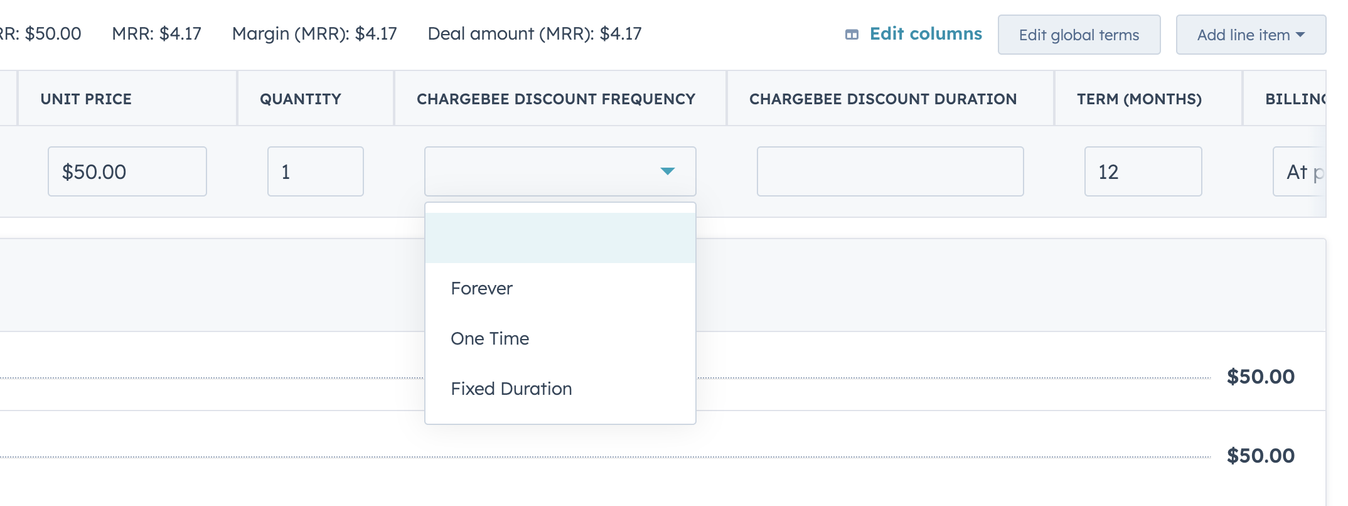
- Chargebee Frequency
- Chargebee Discount Duration
Chargebee discount duration has following three possible values. These options indicates how long the Unit Discount is applicable to the related Chargebee line item.
- Click Save.
Sync Subscriptions from Chargebee to HubSpot
To enable this feature, follow these steps:
-
Enable Sync subscriptions from Chargebee to HubSpot.
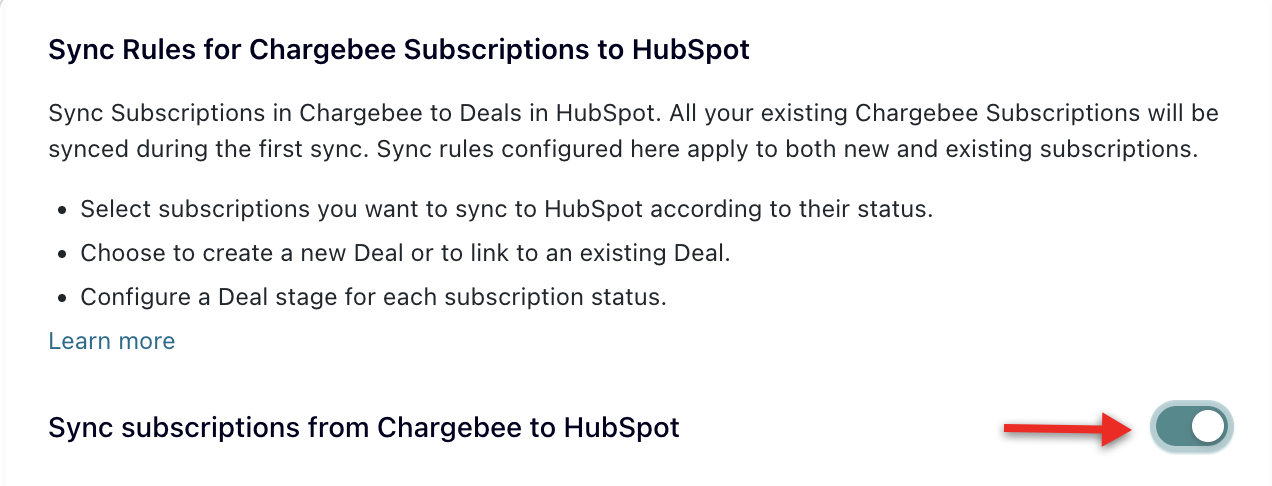
-
Set up Sync Rules for Subscriptions
- Select one or more subscription statuses that you want to sync. The options are:
- Active / Non-Renewing: Syncs Chargebee's active or non-renewal subscriptions to deals in HubSpot.
- In Trial: Syncs Chargebee's trial subscriptions to deals in HubSpot.
- Future: Subscriptions whose start date is in the future, this option syncs Chargebee's future-dated subscriptions to deals in HubSpot.

- Select how you want to sync subscriptions to HubSpot. The options are:
- Always create a new Deal: On selecting this option, a new deal will be created in HubSpot whenever the subscription sync is triggered.
- Only link to a matching Deal: On selecting this option, an existing deal will be updated in HubSpot whenever there is a match between a subscription and a deal. The matching criteria are shown in the image below.
- Link to a matching Deal, and create a new Deal if a match isn't found: On selecting this option, an existing deal will be updated whenever there is a match between subscription and deal. If no match is found then a new deal will be created in HubSpot. The matching criteria are shown in the image below. Note: For finding a match for a Deal, select Only link to a matching Deal or Link to a matching Deal, and create a new Deal if a match isn't found. For details, see the following image.
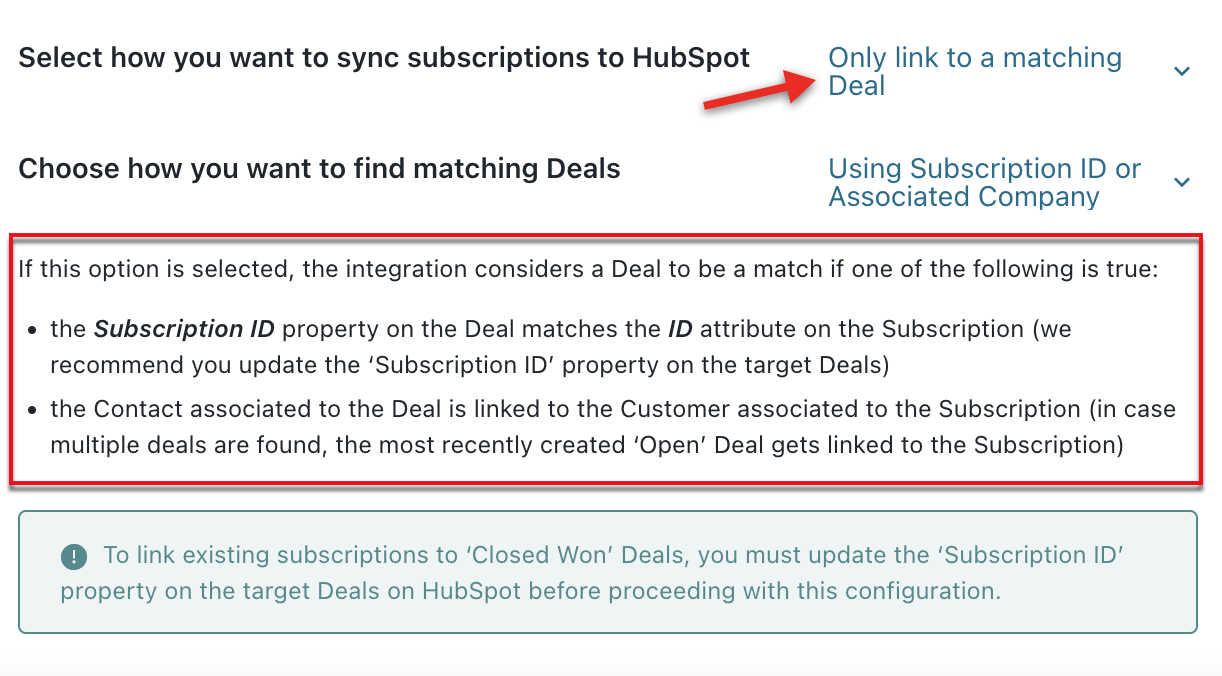
- Select from When a Subscription is Upgraded in Chargebee options to handle Deals related to a Subscription, when a Subscription upgrade takes place in Chargebee. A subscription is upgraded when one or more of the following scenario(s) occur:
- The plan changes from metered to non-metered.
- The plan amount increases without changing the plan, and it is non-metered.
- The plan amount increases, and the plan changes from non-metered to non-metered.
Select from the following options:
- Create a new Deal: A deal will be created in HubSpot reflecting the upsell of the subscription change.
- Update the linked Deal: If the subscription was originally created from HubSpot, this will update the original deal to reflect the subscription upsell.
- Do Nothing: Subscription upgrades will be reflected on the CRM card, but no deal will be created or updated in HubSpot.

- Choose the value that you want to sync into the Deal Amount field in HubSpot from the options as required.
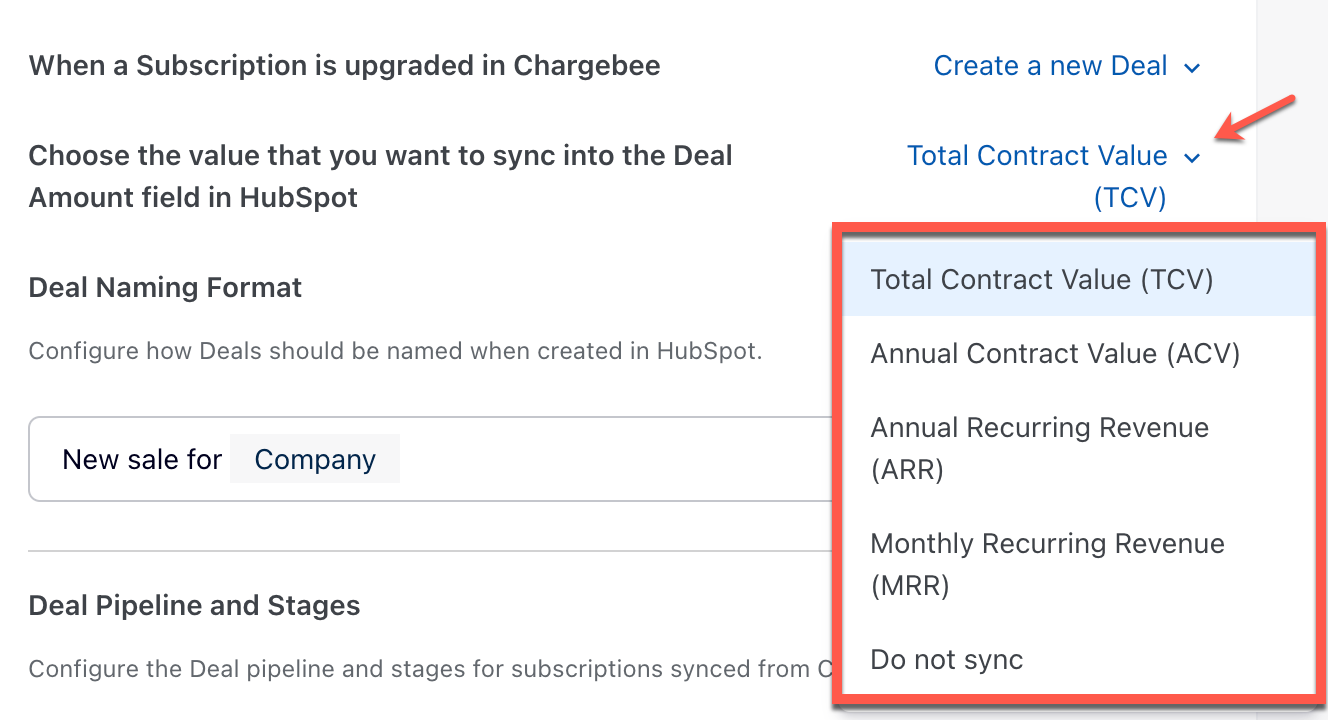
- Set up the Deal Naming Format. Click Change.

- Configure the Deal Naming Format that you want to show as the Deal name in HubSpot. For example, suppose you want to configure the Deals name for a New sale of a specific Company with Chargebee's subscription ID, it may appear as shown below. The following are the Chargebee fields that you can add to configure the Deal Naming Format.
- Customer ID: Unique identifier of the customer.
- Subscription ID: Unique identifier of the subscription.
- Company: Name of the company for which you are syncing the subscription.
- First Name: First name of the customer.
- Last Name: Last name of the customer.
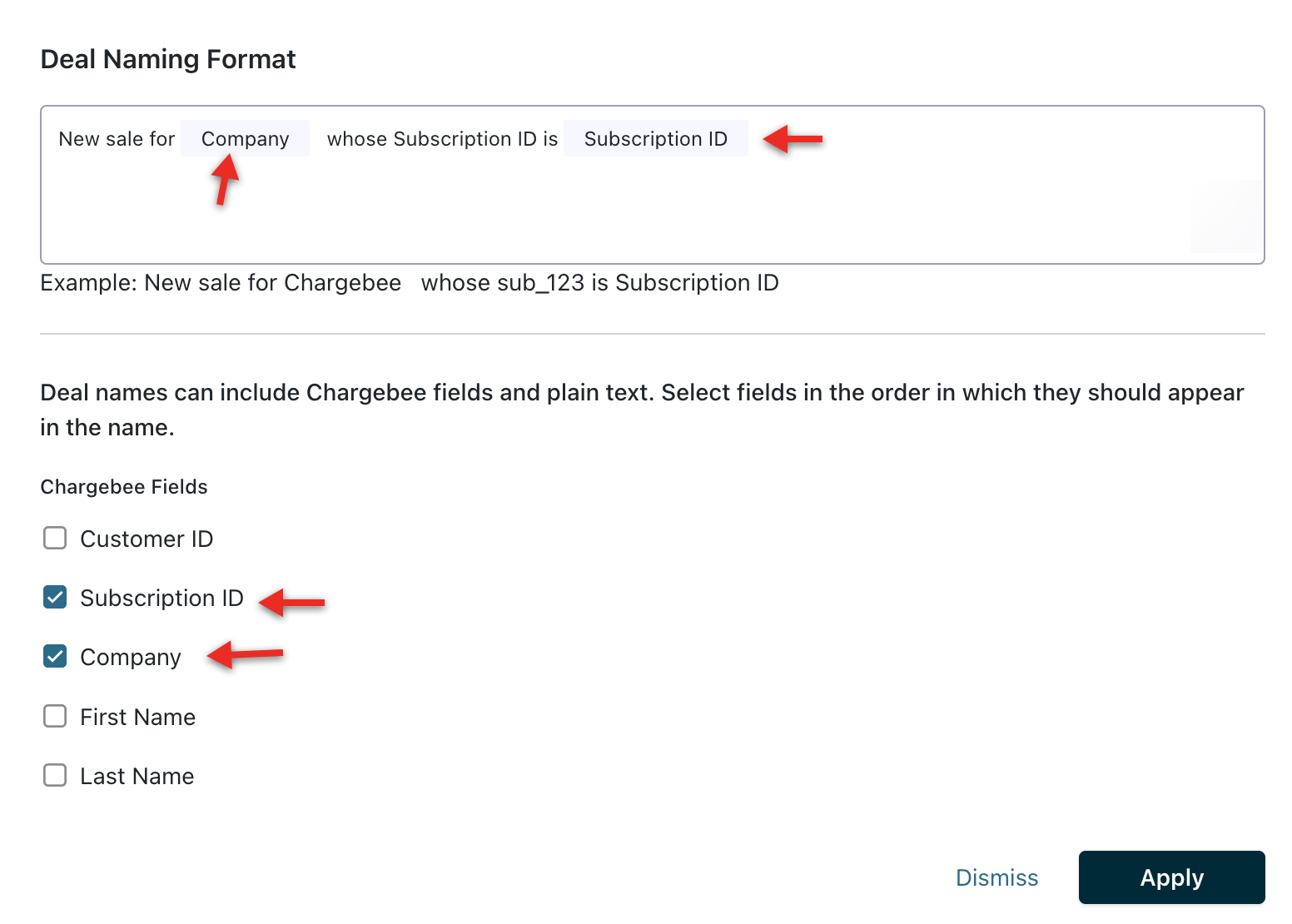
- Click Apply and view the changes.

- Configure the Deal Pipeline and Stages.
- Select the pipeline where Deals should be synced: Chargebee will display all the pipelines that you have configured in your HubSpot account. Select the pipeline that you would like to use.
- Select the Deal stage for Subscriptions in different stages: Map the Chargebee Subscription Status with HubSpot Deal Stage as required.
- Chargebee Subscription Status: You cannot change Chargebee Subscription Status options, these options appear based on your configuration on Select subscription statuses that you want to sync. You will get a detailed explanation of these statuses in Step 2.1.
- HubSpot Deal Stage: You can change HubSpot Deal Stage options using this mapping. For example, consider Chargebee's active or non-renewal status which is mapped to the Appointment Scheduled deal stage as shown below. Now if you want to change the deal stage to any other stage you can do that using this option and it will replicate in HubSpot with the upcoming sync.
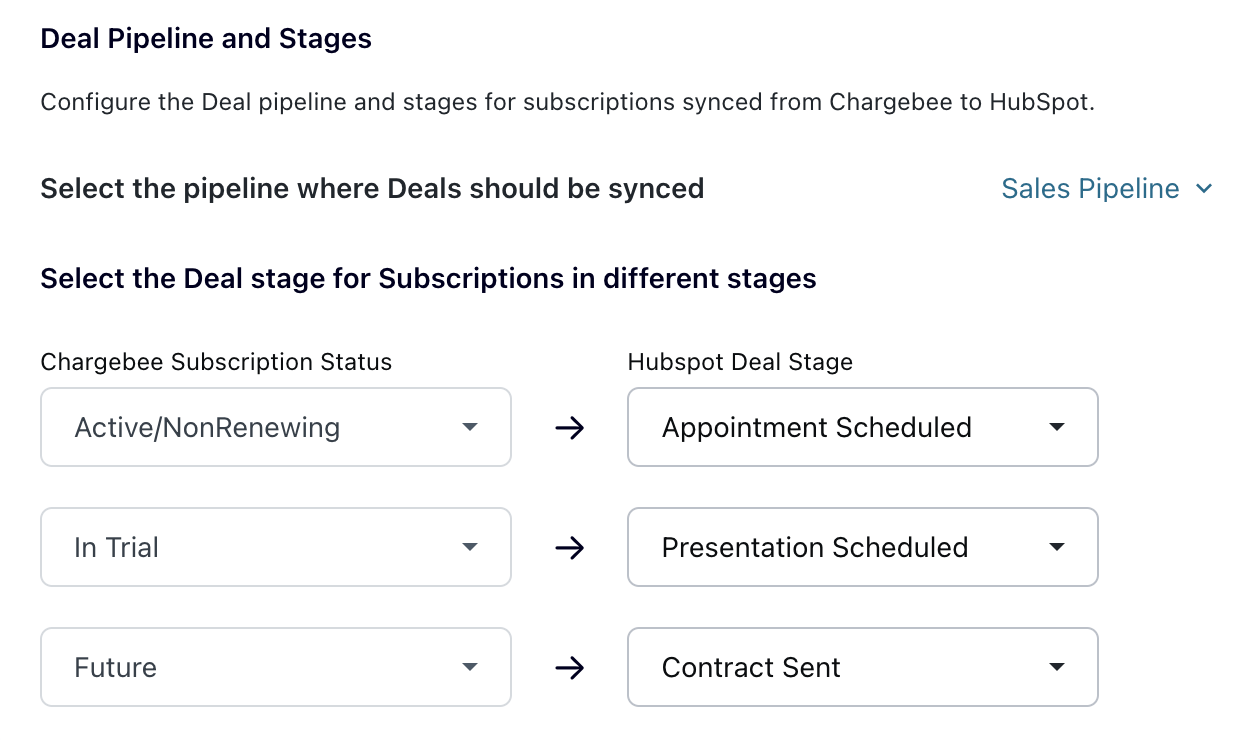
-
Click Proceed to go to the Sync Additional Data.
Sync billing address via custom HubSpot fields instead of standard fields
Enable this setting to sync billing address information from custom billing address fields in HubSpot to standard billing address fields in Chargebee.
Note:
This option should only be used if you have set up custom billing address fields within a company object in HubSpot and do not wish to sync records with HubSpot's standard billing address fields.
Configuring custom billing address fields
- Create custom billing address fields in HubSpot.
- Select HubSpot under Apps on your Chargebee site.
- On the right pane, click Manage sync preferences.
- Turn on the Sync billing address via custom HubSpot fields instead of standard fields toggle.
- Select the required custom billing address fields from the HubSpot Company Field dropdown list, and then map those fields by selecting the appropriate fields from the Chargebee Customer Field dropdown list.
- Click Apply Changes.
Sync rules for quotes
Enable this option to send Chargebee quotes from HubSpot, sync quote details back to the deal, and automate subscription conversion.
Note:
This is a paid feature. Contact Chargebee’s sales team to learn more.
Sync HubSpot Deal to Chargebee Quote
The following deal information is prepopulated in Chargebee quotes by default:
Map HubSpot Deal Types to Chargebee Quote Types
Choose the HubSpot deal types to link with Chargebee quote types, such as New Business and Amendment/Renewal.
Sync Chargebee Quote to HubSpot Deal
Sync Chargebee quote custom fields with HubSpot deal properties.
Sync HubSpot deal stage with Chargebee quote status
Automatically sync HubSpot deal stages with Chargebee quote statuses. For example, to auto-create a subscription, mark the quote as Invoiced when the deal is closed or won.
Note:
You can create separate rules for each HubSpot pipeline.
Company synchronization
The integration syncs company records in HubSpot to customer records in Chargebee.When a company record is synced to Chargebee for the first time, a new customer record is created in Chargebee and mapped to it. No existing customer records are checked to find a match. Once a company is synced to Chargebee as a customer record, subscriptions created from deals associated with the company are created against the same customer in Chargebee.
When the integration syncs company records, the Country / Region property from HubSpot is synced to customer.billing_address.country in Chargebee. During the sync, the integration converts the country name from HubSpot to their corresponding ISO country codes and maps them to Chargebee. However, in rare scenarios, there is a mismatch between the country name and its ISO code, resulting in errors during conversion. For example, in Chargebee the country South Korea is stored as KOREA (Republic) whereas HubSpot stores it as Korea, Republic of. Due to this mismatch, the integration fails with an invalid country name error.
However, you can modify the country name Korea, Republic of in HubSpot to KOREA (Republic) and successfully sync company records, create subscriptions, and checkout links.
Note:
- The information flows only from HubSpot to Chargebee for the company records and never the other way around.
- Ensure that all address fields listed below are updated at the company level in HubSpot to reflect changes in the address within Chargebee:
- City
- State
- Country
- ZIP code
- Address line 1
- Address line 2
See also
Field-mapping for the company object.
Configuring company synchronization
Chargebee allows you to map up to 15 additional fields for syncing from company records in HubSpot to customer records in Chargebee. Any changes to these additional field values replace the current value when the integration syncs company records. However, blank values in HubSpot do not overwrite values in Chargebee. The steps are as follows:
- Click Apps > Go to Marketplace > Sales & CRM.
- Click HubSpot Quote To Cash under the Apps connected section.
- On the right pane, click Manage sync preferences.
- Add the required fields under Map Additional Fields for Company.
Under the HubSpot Company Field dropdown list, the available options are the standard or custom properties belonging to the following property groups in the company object:
- Sales properties
- Company information
- Target accounts information
- Any other custom property group
Similarly, under the Chargebee Customer Field dropdown list, the following properties on the Chargebee customer are available for selection:
- Auto collection
- Net payment terms (Net-d)
- Language/locale
- Preferred currency
- VAT Number
- Allow customer to pay via bank account
- Any custom fields defined for the customer object.
Warning
Field Compatibility The fields available for Chargebee are only those that are compatible with the type of property selected for HubSpot.
Contact synchronization
Contacts in HubSpot are synced to Customer records in Chargebee. However, this is optional and only applicable to those contacts which meet the following criteria:
- The contact is associated with a company record.
- The contact has one or both of the following properties set to Yes:
- Chargebee Primary Contact
- Chargebee Billing Contact
See also
For more information on how a contact's fields affect sync behavior, read the Field Mapping reference for Contact.
Deal synchronization
Properties of Deals and Deal Line Items in HubSpot are used to determine the attributes of Subscription records in Chargebee. Once a company is synced to Chargebee as a customer record, subscriptions created from deals associated with the company are created against the same customer in Chargebee. A number of workflows are available to create subscriptions out of deals.
Configuration
Map Additional Fields for Deals
Chargebee allows you to map up to 15 additional fields for syncing from deal records in HubSpot to subscription records in Chargebee. Any changes to these additional field values replace the current value when the integration syncs deal records. However, blank values in HubSpot will overwrite values present in Chargebee. The steps are as follows:
- Click Apps > Go to Marketplace > Sales & CRM.
- Click HubSpot Quote To Cash under the Apps connected section.
- On the right pane, click Manage sync preferences.
- Add the required fields under Map Additional Fields for Company.
Under HubSpot Deal Field, the available options are the standard or custom properties belonging to the following property groups belonging to the deal object:
- Deal activity
- Deal revenue
- Deal information
- Analytics history
- Any other custom property group
Similarly, under Chargebee Subscription Field, the following properties on the Chargebee subscription are available for selection:
- Auto collection
- Any custom fields defined for the subscription object.
Warning
Field Compatibility The fields available for Chargebee are only those that are compatible with the type of property selected for HubSpot.
Enable ‘Create Subscription' Button
You can manually create a subscription from HubSpot when this option is selected. A ‘Create Subscription' button is available in the right pane of the HubSpot application. Enabling the toggle displays an access key.
See also
For more information, see create a subscription from the UI
Settings for creating subscriptions
Create subscriptions manually from HubSpot
This option allows you to manually create a subscription from HubSpot. Once this option has been enabled, a Create Subscription button appears in the right pane of the HubSpot application. Enabling the toggle displays the permanent access key. Copy the access key and store it in your password manager. Use this key each time you create a subscription. If the Chargebee site is connected with multiple business entities, a unique access key is associated with each business entity. For more information, see creating a subscription via UI.
Create subscriptions as contracts from HubSpot
This option allows you to create subscriptions with contract terms out of HubSpot deals. Contract term settings configured in Chargebee are taken as the input. You can view the contract terms fields on HubSpot only after enabling contract terms for your Chargebee site.
Enabling autosync
The autosync feature runs the sync job between HubSpot and Chargebee automatically every 15 minutes. You can enable it as follows:
- Click Apps > Go to Marketplace > Sales & CRM.
- Click HubSpot Quote To Cash under the Apps connected section.
- Enable the toggle Autosync enabled. At any point in time, you can trigger a sync manually by clicking Sync Now.
Note:
Error Retires Whenever certain records fail to sync between HubSpot and Chargebee, they are automatically retried every 24 hours.You can also trigger a manual retry of these records by clicking Sync Now.
Sync Dashboard
Sync Dashboard displays an overview of the records that synced from Chargebee to HubSpot.
Based on the latest sync, the dashboard displays the following information:
- Number of customers synced successfully: The number of newly synced customer records or the number of records synced as part of an update in HubSpot from Chargebee.
- Number of failed records: The number of records that failed to sync.
- View sync log: Click View sync log to view the consolidated list of synced records and their properties from all sync actions.
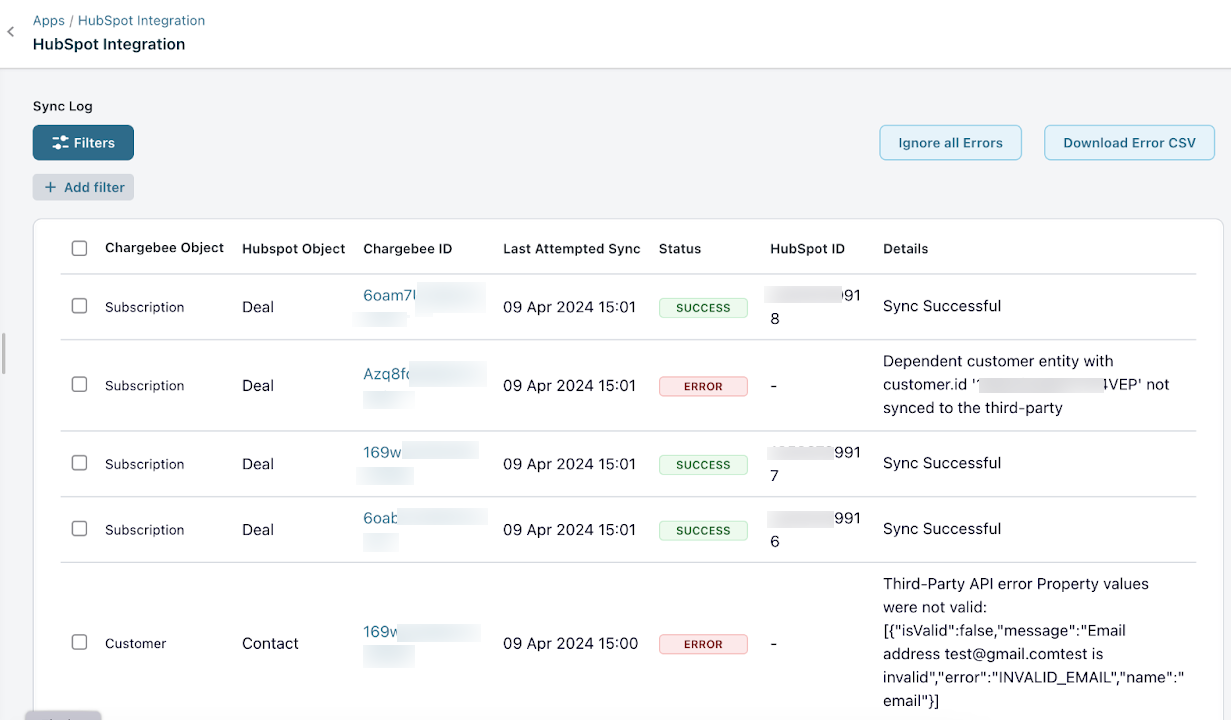
- Filters: You can apply filters to your sync log view, making it easier to find errors based on Sync Status, Chargebee Object, HubSpot ID, or Chargebee ID.
- Ignore All Errors: All errors will be marked as ignored and no longer synced between Chargebee and HubSpot.
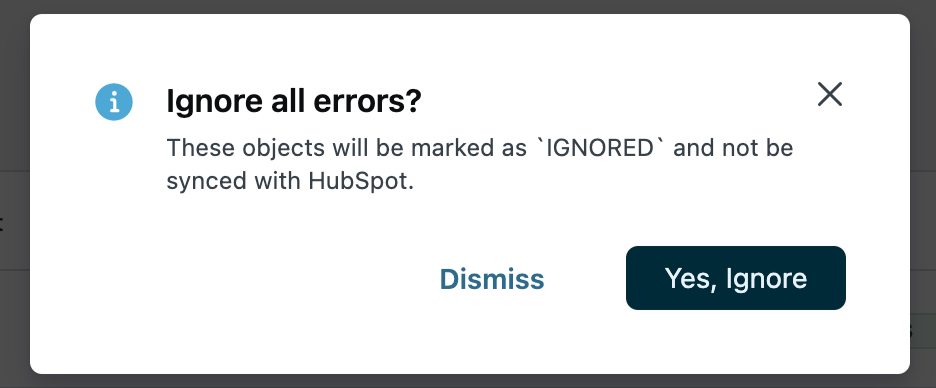
- Download CSV: Export your sync log data into a CSV for offline usage.
- Selecting a record shows these options:
- Retry Sync: Simple retry of the record based on its latest attributes.
- Redirect Sync: Deletes the sync entry before retrying based on its latest attributes.
Supported data types for fields
Additional fields can be configured for syncing from HubSpot to Chargebee. This section lists the supported data types for fields in HubSpot and Chargebee when configuring additional fields to be synced for Company or Deals.
HubSpot Data Types
The following field data types are supported for syncing from HubSpot:
- Single line text
- Dropdown select
- Single checkbox
- Date picker
- Number (formatted or unformatted)
Chargebee Data Types
The supported field data types in Chargebee depend on the data type of the corresponding field in HubSpot. The following is the complete list of field data types supported for syncing to Chargebee:
- Single line text
- Number
- Dropdown
- Checkbox
- URL
- Date picker
Unlinking the Integration
To unlink your HubSpot Quote to Cash integration from Chargebee, follow these steps:
-
Log in to your Chargebee account > Go to Apps.
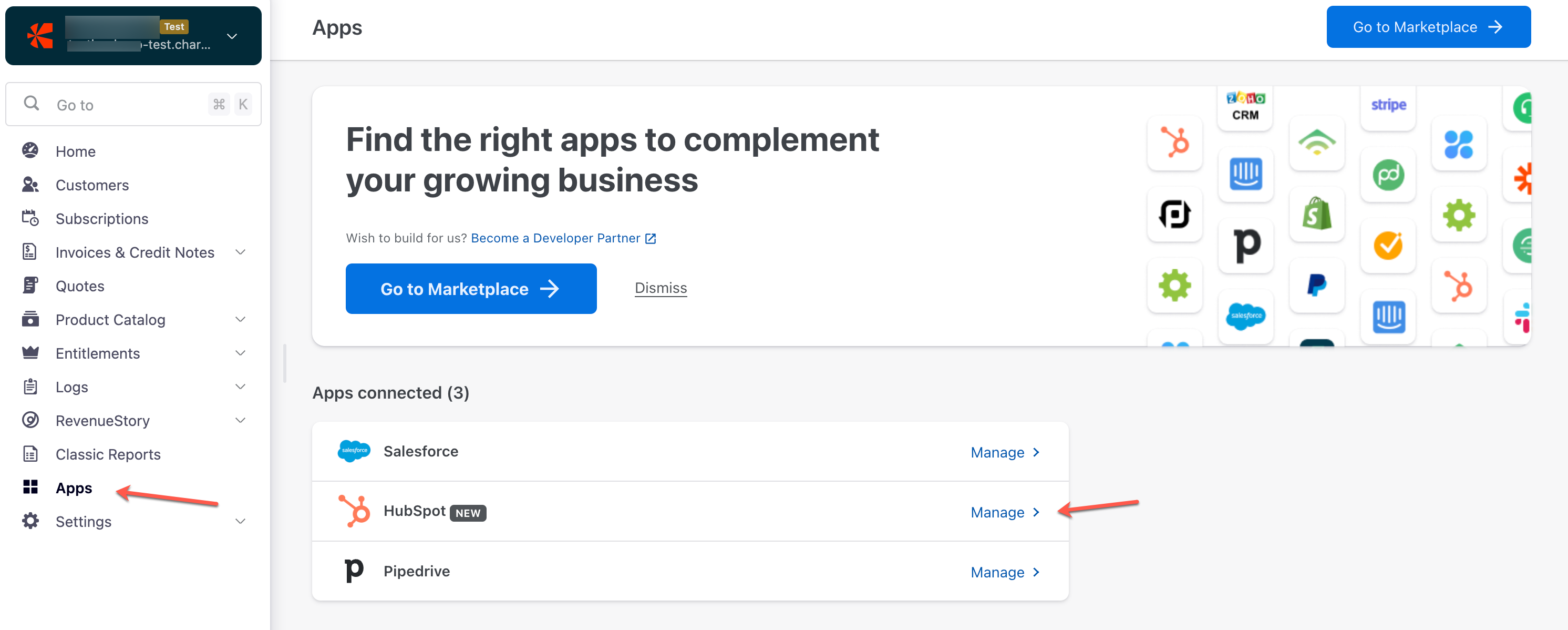
-
In the Apps connected section, click on HubSpot.
-
On the HubSpot Integration page, click on the unlink integration hyperlink.

-
A pop-up window appears asking you to confirm unlinking, click Confirm.
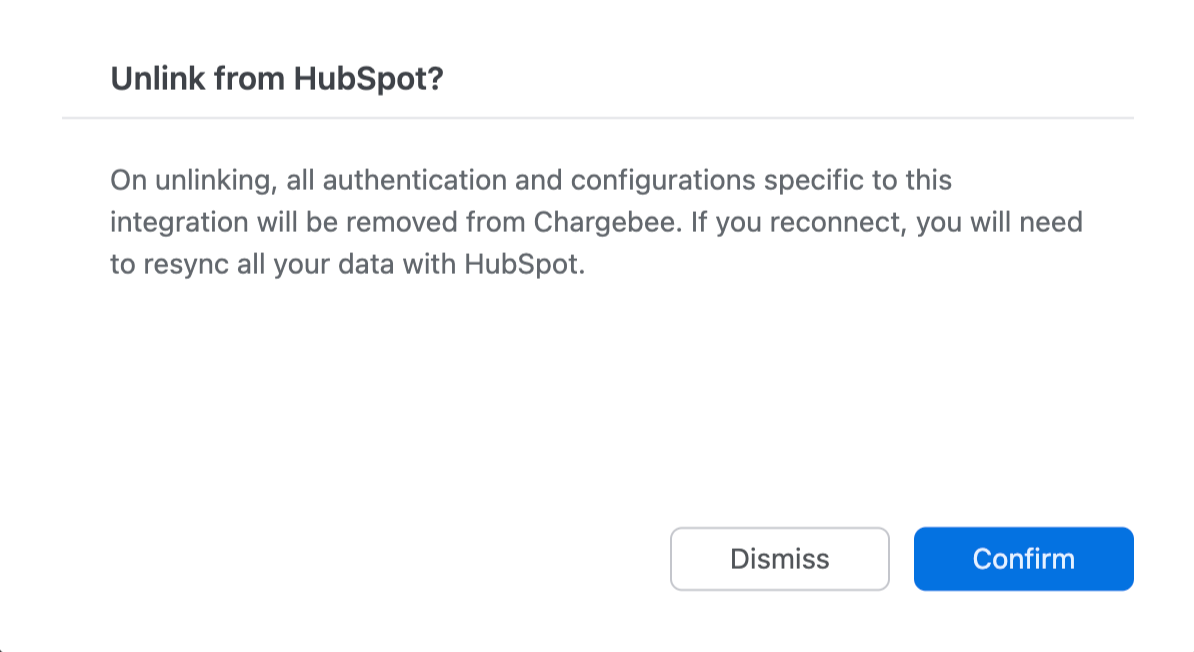
Once you have completed the unlinking, Chargebee will delete the mapping and remove the connection to HubSpot. It is important to note that although the integration is removed the data stays in both systems.
Unlinking Integration in a Multi-Business Entity enabled site
If you have Multi-Business Entity enabled on your Chargebee site, you can unlink your HubSpot Quote to Cash integration by following the steps given below:
-
Log in to your Chargebee account > Go to Apps.

-
In the Apps connected section, click on HubSpot.
-
On the HubSpot Integration page, click on the unlink business entities hyperlink.
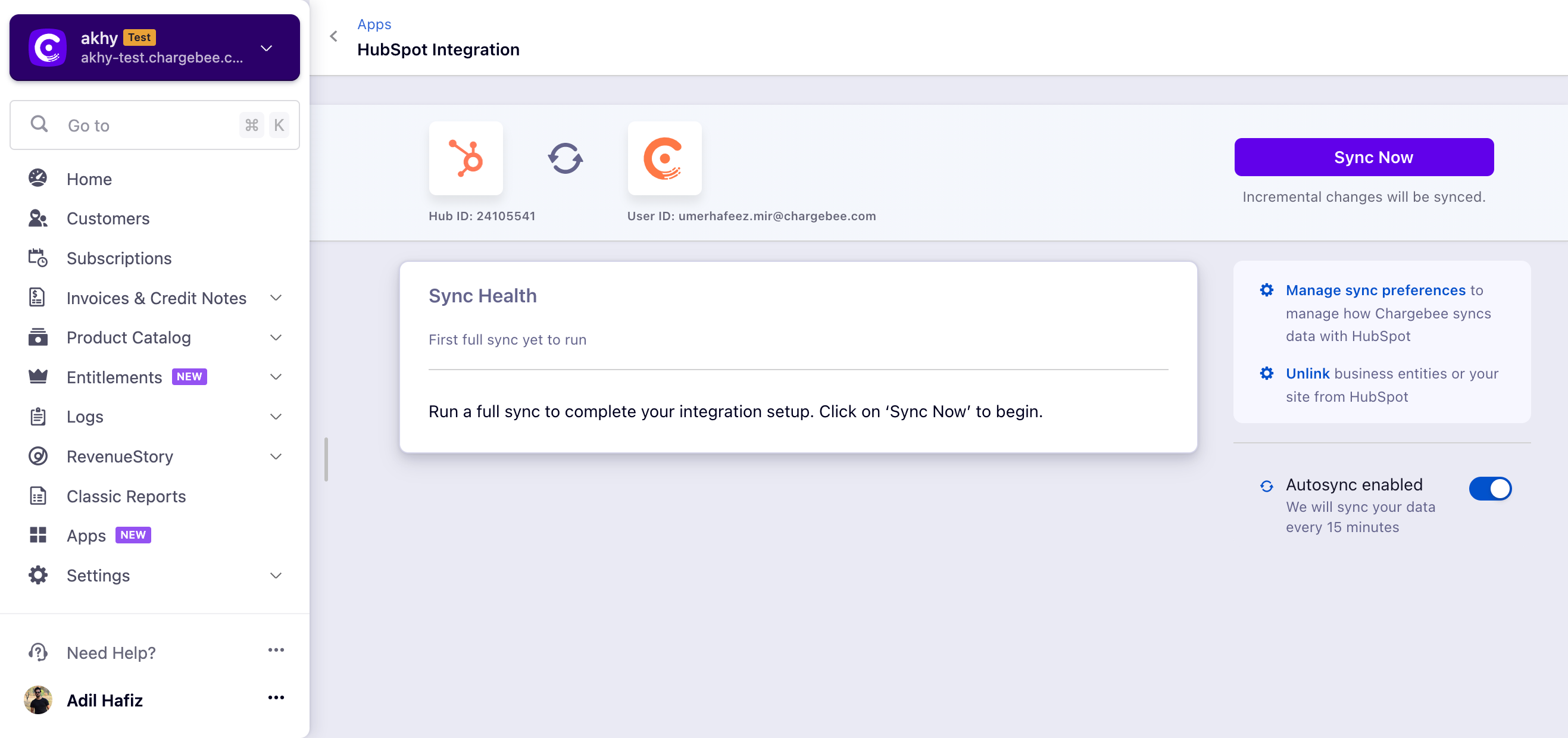
-
Unlink all business entities or select to unlink specific business entities, click Next.
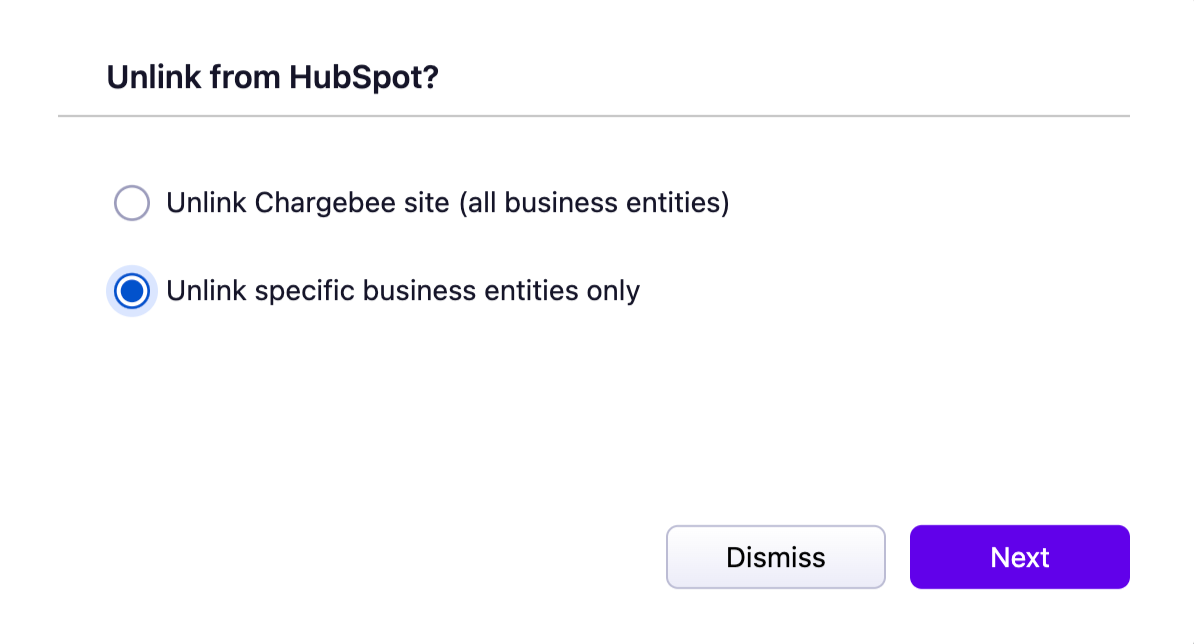
-
If you checked the Unlink specific business entities only, a pop-up window appears asking to you choose the specific business entity you want to unlink. Alternatively, if you select unlink the Chargebee site, all the associated business entities and their configurations are removed.
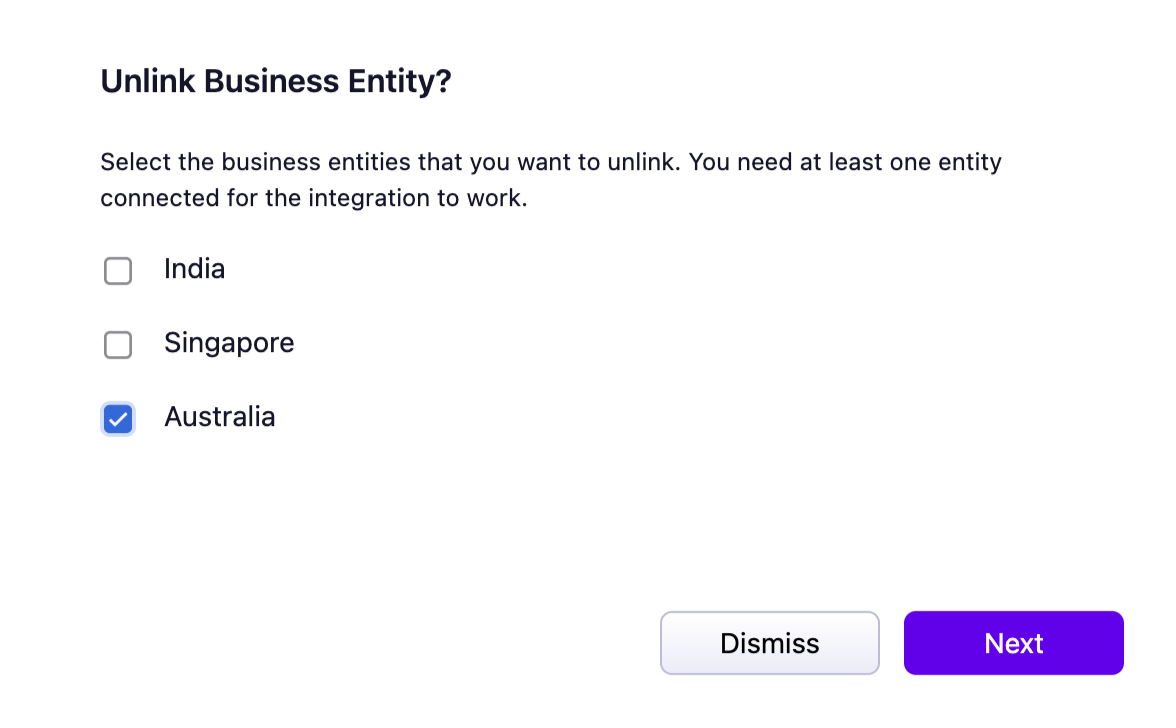
-
Choose the business entity to unlink > Click Next > Confirm
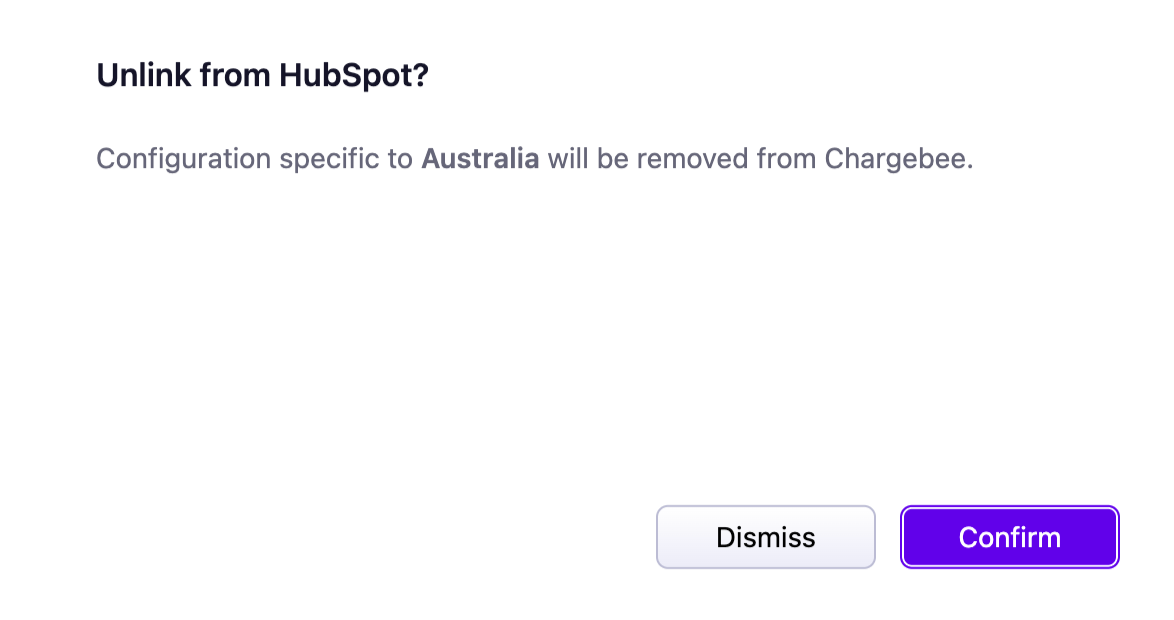
Once confirmed the business entity will be unlinked from your HubSpot integration. Although the business entity is removed from the integration the data stays in both systems.
You can reconnect a business entity with your HubSpot by clicking on the Connect Business Entities hyperlink in the HubSpot integration screen.
Uninstalling Integration from HubSpot
Uninstalling the integration from HubSpot will cease the connection between your Chargebee account and HubSpot account. All the existing Chargebee data in HubSpot will remain but you will no longer be able to use the integration for syncing any data from Chargebee to HubSpot or vice-versa.
To disconnect an app from your HubSpot account:
-
In your HubSpot account, click the Marketplace icon on the navigation bar.
-
Click Manage > Connected apps.

-
Click Actions, then click Uninstall.
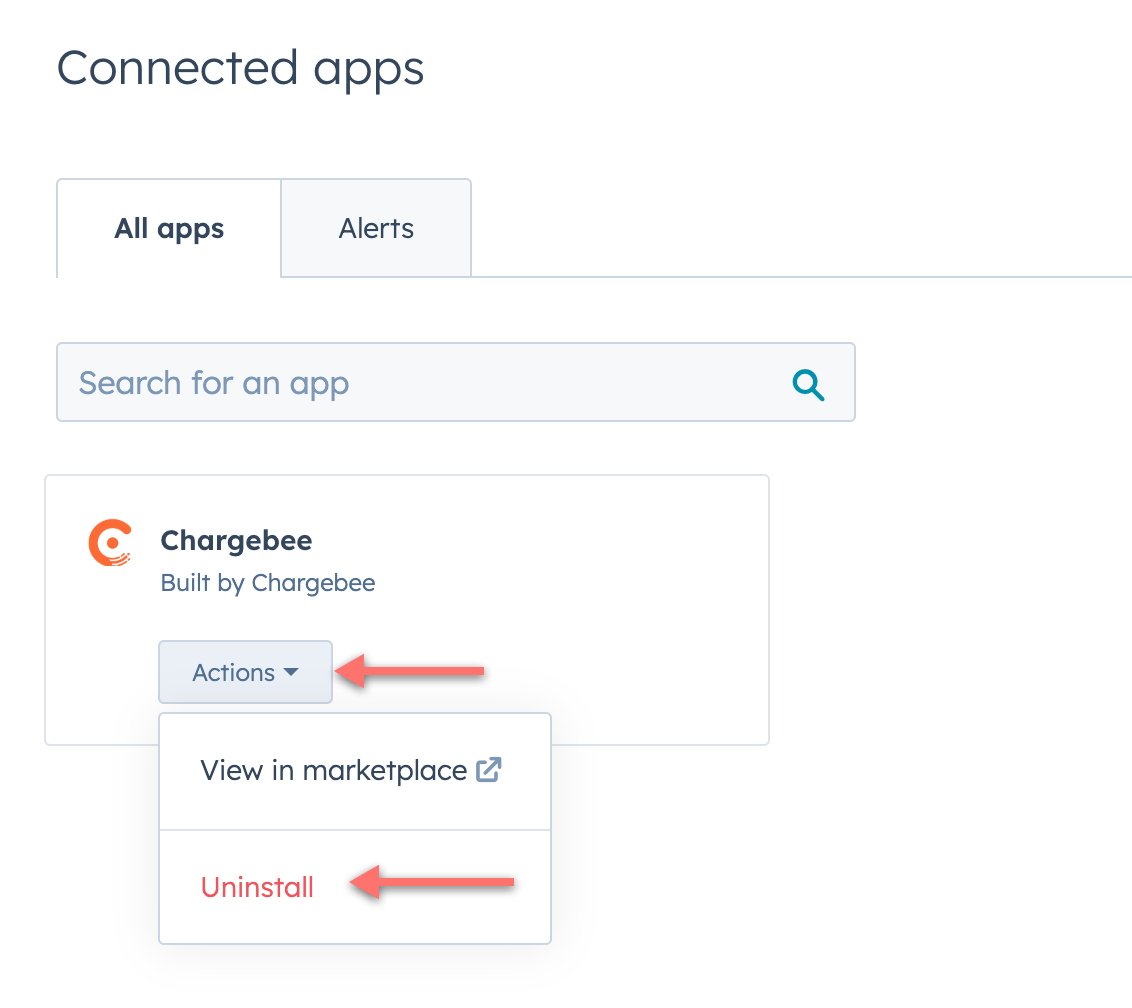
-
In the dialog box, type uninstall in the text box and click Uninstall.
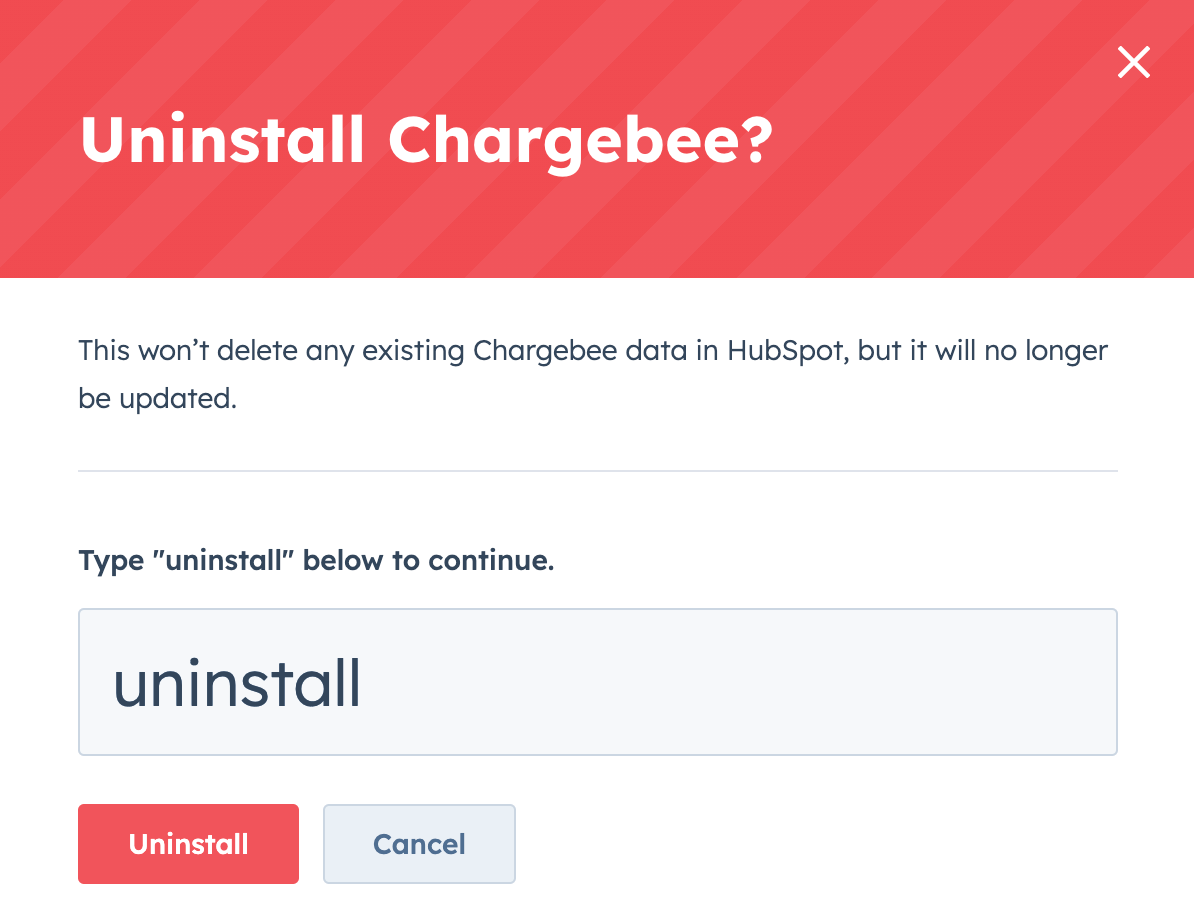
Learn more about uninstalling the integration from HubSpot.
Was this article helpful?